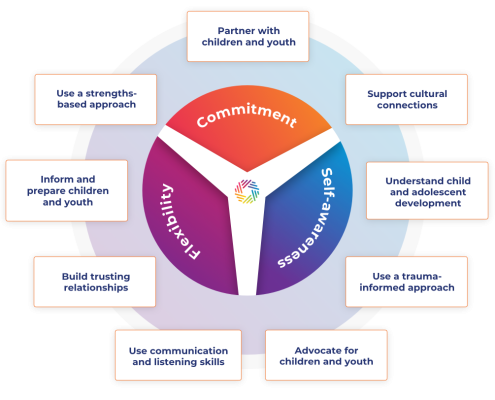The QIC-EY defines competencies as knowledge, skills and abilities that child welfare workers can hone through training, practice and support.
The Quality Improvement Center on Engaging Youth in Finding Permanency (QIC-EY) is producing a series of Lessons Learned to share fundamental insights about authentic engagement with children and youth, especially in relation to permanency decisions. Each lesson brings to life insights and knowledge gained as the QIC-EY project progresses.
The Quality Improvement Center on Engaging Youth in Finding Permanency (QIC-EY) Literature Review has found and has identified three characteristics — highlighted in Lessons Learned (No. 3) — plus nine competencies that facilitate child welfare workers’ ability to engage authentically with children and youth.
The Lesson
The QIC-EY defines competencies as knowledge, skills and abilities that child welfare workers can hone through training, practice and support.
The nine competencies are essential to relationship building and partnering with children and youth. As a high priority, child welfare systems need to provide opportunities for their professionals to develop and to fine-tune these competencies. When these competencies are understood, developed and supported continually, the child welfare workforce truly can center on engaging authentically with children and youth.
The nine competencies are:
- Partner with children and youth.
- Build trusting relationships.
- Inform and prepare children and youth.
- Use a strengths-based approach.
- Use communication and listening skills.
- Advocate for children and youth.
- Support cultural connections.
- Understand child-and-adolescent development.
- Use a trauma-informed approach.
Application of the Lesson
Recognizing that ongoing skill development is essential and that finding time to lean into learning can be challenging, the QIC-EY team has produced a multimedia tool that brings the nine competencies to life. Entitled “No Opportunity Wasted for Making Moments Matter with Children and Youth” (QIC-EY NOW), it features real-life stories from the field, short audio and video clips, plus quick tips for busy child welfare professionals to embody these competencies in their work with children and youth.
Whether used by individuals or in groups, the QIC-EY NOW clips and tips will help child welfare professionals to validate the work that they already are doing. In addition, the QIC-EY NOW materials will encourage a deeper understanding of authentic engagement with children and youth and will facilitate skill development in this area. Using QIC-EY NOW is as easy as:
- choosing a competency;
- listening to that competency’s definition, example and tips;
- reflecting on how to become more active in engaging authentically with children and youth.
Your agency or organization can utilize the QIC-EY NOW tool to develop the nine competencies further. This process can be as simple as doing the following:
- Show one of the QIC-EY NOW clips and tips during a staff meeting. Ask the staff members attending to offer examples that show how they are applying these competencies in their daily work of engaging with children and youths.
- Encourage supervisors to use the QIC-EY NOW clips and tips to describe for their staff members how these nine critical competencies can be employed in real life.
- Establish a system of support and acknowledgment for staff members when they show these competencies in their daily work. (For example, prominently display a shout-out board that highlights a staff member who has received a compliment related to one of these competencies or has been seen exhibiting one of these competencies.)
- Ask supervisors and administrators to identify workers who are displaying these competencies in their work. Submit this information to the QIC-EY team to add to examples of the competencies being employed in the field.
If child welfare systems collectively embrace the power of knowledge and provide opportunities for their staff members to keep learning and to continue developing their skills, then their shared mission to create a world where every child and youth feels seen, heard and valued will be honored. Deeper connections between children and youth and child welfare professionals become possible when the competencies that drive relationship building are understood, developed and supported continually. The QIC-EY NOW tool can help you and your staff members to progress along the journey toward more authentic engagement with children and youth.

